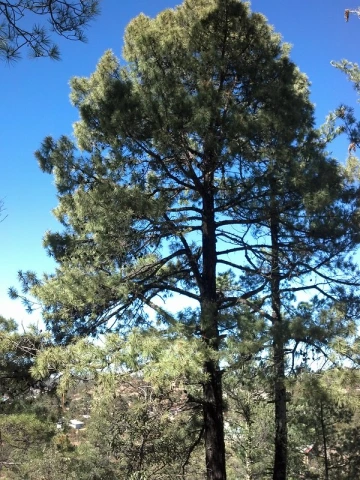
Anthony Mendoza Flickr.com
Botanical Family: Pinaceae
Scientific Name: Pinus arizonica
Common Names: Arizona pine, pino de Arizona
Botanical Description:
Pinus arizonica is a coniferous tree that was previously considered a variety of Pinus ponderosa, but is now recognized as a separate species. P. arizonica can be differentiated by possessing up to 5 needles per fascicle rather than 2-3, and a more open crown than P. ponderosa (1). Arizona pine grows up to 112 feet tall, with a trunk up to 48 inches wide (2). The thin, scaly bark is divided into irregular plates that are reddish-brown as a juvenile, but become gray in older specimens (3). The crown of mature trees is open and rounded, while younger trees possess a pyramidal habit (2). Branchlets are glaucous or orange-brown, terminating in fascicles of 3-5 straight or slightly twisted needles, yellowish-green or glaucous in color (3, 4). The symmetrical seed-cones appear in groups of 1 to 3 on short, stout peduncles. Cones are reddish-brown when mature, ovoid and slightly curved, with stiff, hard scales and slender spines (2, 4). The cones are deciduous, leaving the peduncle and opening at maturity to reveal light-brown seeds with grey-brown wings (2, 3).
Ecological Significance:
Arizona pine occurs within numerous plant communities of the American Southwest, including pure strands, pine-oak communities, and montane mixed-conifer forests (4). The ecosystems are integral to the survival of wildlife species, including rodents, lagomorphs, deer, and birds. Breeding populations of Mexican junco and Mexican chickadee, thick-billed parrots, and numerous other species of neotropical birds utilize Arizona pine forests for nesting, foraging, and roosting. Common porcupines and smaller rodents feed upon the bark and wood, deer consume the buds and woody shoots, while the seeds are a staple in the diets of southwestern birds, rodents, and lagomorphs. Arizona pine provides cover for songbirds, upland gamebirds, small mammals, carnivores, and ungulates. At the same time, large strands provide carbon sequestration and watershed protection to forest ecosystems (1).

